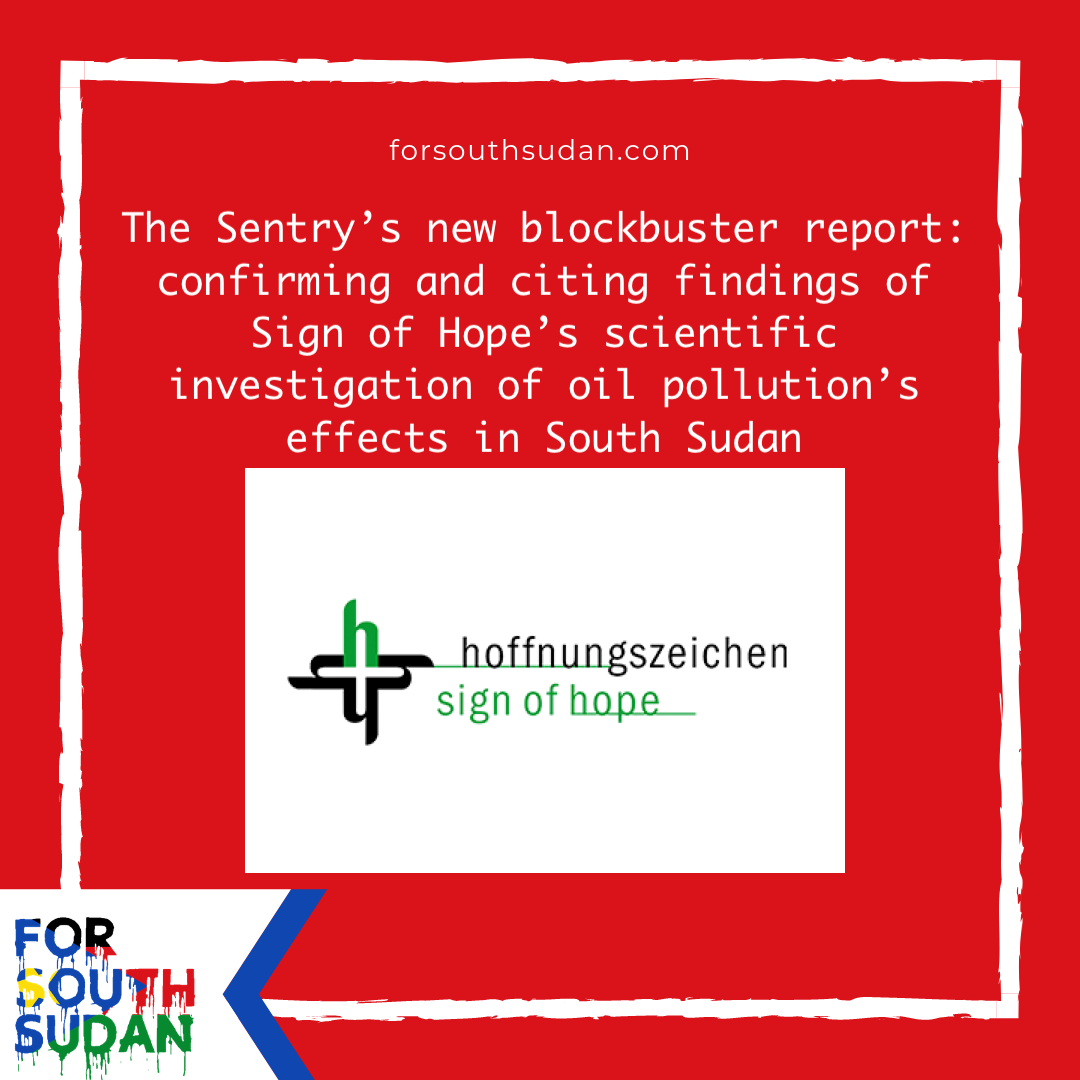https://cdn.thesentry.org/wp-content/uploads/2019/09/TakingOfSouthSudan-Sept2019-TheSentry.pdf
“The Taking of South Sudan”
Key quote in report:
“Klaus Stieglitz, vice-chairman of the
Konstanz,Germany-based non-profit organization Sign of Hope that
has previously investigated pollution
concerns in South Sudan, speaks of an “oil catastrophe”
affecting more than 600,000 people.”
Key findings in report on oil pollution:
“Oil production in Upper Nile state has contaminated the environment and threatened the health of the adjacent population in Upper Nile state.”
“Extremely high” and “elevated” levels of heavy metals – such as lead and mercury – and of dangerous chemicals – such as PAHs, TPH and BTEX” – often linked to infant stillbirths and deformities – found in and around oil fields
Widespread and vociferous protests by local
residents and officials have been stifled and ignored by
government.
This contamination of water and land has been caused by the widespread and deliberate failure to adhere to environmental standards by the Dar Petroleum Operating Company – in which Petronas of Malaysia and China National Petroleum have major equity stakes.
Quoting from the report:
Hazardous Waste
Oil production in Paloch and Adar has contaminated the environment
and threatened the health of the
adjacent population in Upper Nile state. An unpublished study
commissioned by Dar Petroleum about
the management of hazardous waste associated with its oil
production in Upper Nile shows the extent
to which the company is aware of its role in the environmental
damage.
Prepared for Dar Petroleum by consulting firms Envirocare and
Enviroserv, the internal study documents
found elevated levels of heavy metals and several dangerous
chemical compounds in sites around
Dar Petroleum’s production facilities. In some instances, the
researchers warned of “extremely high”
levels of dangerous chemicals. At dumpsites near the oilfields,
the researchers found that high levels
of accumulated lead and mercury, and some waste pits had elevated
levels of arsenic. In numerous
locations, the researchers found heightened levels of polycyclic
aromatic hydrocarbons (PAHs), 66 a
class of chemicals produced when petroleum, coal, garbage, wood
and some other products are
burned. 67 The study also documented elevated levels of benzene,
toluene, ethylbenezene and
xylenes—a group of compounds associated with oil production
collectively known by the acronym
BTEX.
The study paints a grim picture of waste management at Dar
Petroleum’s facilities. “The yard is visibly
contaminated,” it said of the Adar oilfield. Images included in
the study of waste sites at Dar Petroleum’s
facilities resemble open, unkempt garbage heaps. Mud pits at the
oilfield used to store waste were
compromised “as a result of liner decay, damage and theft,” the
report found. 68 Dumpsites that
contained “high levels of lead” and “extremely high levels of
PAHs, BTEX and TPH” were characterized
by “inadequate housekeeping.” And at Paloch,“chemicals washing out
of the former yard has lead to
contamination of areas outside” Operational Base Camp. The
contamination thus extended beyond
Dar Petroleum’s facilities.
A November 2018 report presentation by Dar Petroleum depicts
observations at chemical yards and
landfill of Dar Petroleum facilities taken as part of an
integrated hazardous waste management feasibility
study.
Upper Nile residents have long raised concerns about the public
health impacts of oil-related pollution.
“Oil production pollutants are suspected by communities to have
caused many new health problems,
such as increased infertility in women, a higher number of
miscarriages, and eye and skin problems,” a
2014 study by Cordaid found. “According to medical staff in Melut
and Koch, a link between the pollution
caused by oil production and some of these health problems cannot
be excluded. Communities are not
made fully aware of hazards associated with the production of
oil.” 69
“EnviroServ Uganda, as would be expected, respects the
confidentiality of client information and thus
is not willing to share findings and information from the report,”
a representative from the company
wrote in an email in response to questions posed by The Sentry in
September 2019. “[Dar Petroleum]
has shared the report with the relevant authorities in South
Sudan.”
The known public health consequences of exposure to chemicals
identified at Dar Petroleum’s
facilities are significant and reflect similar concerns. Exposure
to PAHs can harm fetal development. 70
Benzene is a known carcinogen, with the World Health Organization
describing Benzene as “a major
public health concern.” 71 And high short-term exposure to
metallic mercury can also cause a range
of medical ailments, including lung damage and elevated blood
pressure or heart rate, according to
the International Petroleum Industry Environmental Conservation
Association. 72
Klaus Stieglitz, vice-chairman of the Konstanz,Germany-based
non-profit organization Sign of Hope that has previously
investigated pollution
concerns in South Sudan, speaks of an “oil catastrophe” affecting
more than 600,000 people. 73


